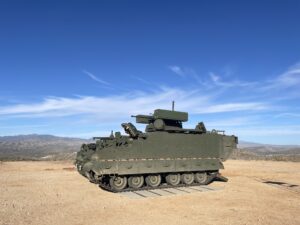BAE Systems recently conducted a successful live fire demonstration with the counter-drone prototype version of its Armored Multi-Purpose Vehicle (AMPV), and is now set to deliver an AMPV outfitted with a turreted mortar payload to the Army in January for a future demonstration.
Bill Sheehy, BAE Systems’ AMPV program director, told
Defense Daily the recent demonstration with the counter-UAS AMPV prototype provided an opportunity to showcase a rapidly integrated payload capability on an AMPV using the company’s newly developed External Mission Equipment Package (ExMEP) universal top plate for the platform.

“The demonstration did everything we wanted it to do. We were able to integrate [the C-UAS payload] quickly. It was 15 months from the start of an idea to when we actually had the vehicle on the ground somewhere shooting,” Sheehy said, noting the internal research and development effort began in July 2022.
BAE Systems unveiled the AMPV C-UAS and first detailed the new ExMEP top plate in October at the Association of the United States Army’s (AUSA) annual conference in Washington, D.C., which company officials said at the time opens possibilities for future variants of the platform (Defense Daily, Oct. 9).
“What we’re trying to show is our ability to integrate quickly to hit the Army’s requirements and give them solutions while keeping it pretty low cost and being able to move fast,” Jim Miller, BAE Systems’ vice president of business development, told reporters at the conference in October. “We think we can put just about anything on an AMPV very quickly as a result [of the ExMEP], which gives the Army lots of options. If they want an engineering vehicle with a remote weapon system on it or if they want an air defense vehicle, it’s very easy to do. If they want some kind of rocket launcher…or it’s on a turret, we can make it work.”
BAE Systems’ AMPV is the Army’s replacement for its legacy M113 armored personnel carriers, with the service reaching the “first unit equipped” marker for the new platform in March (Defense Daily, March 14).
The Army recently awarded the company a full-rate production contract for AMPV, which may be worth up to $1.6 billion, and is delivering five current variants: a general purpose vehicle, the mission command vehicle, a mortar carrier, a medical evacuation vehicle and a medical treatment vehicle (Defense Daily, Sept. 1).
“At AUSA, I can’t even tell you the number of people I sat in the back of that vehicle with and they would look around and say, ‘This universal top plate is a stroke of genius. This is perfect.’ Because it allows the whole field to be in play. We didn’t go and partner with any one organization. We didn’t limit ourselves,” Sheehy said.
Sheehy said the AMPV C-UAS shot down a total of six drones with 13 rounds during the Nov. 15 live fire demo at Big Sandy Range in Kingman, Arizona, noting there was U.S. Army attendance at the event.
“We shot everything from ground to air targets. We shot stationary and moving ground targets at various ranges. And that was to fully show the integration. We shot both stationary and moving drones and multiple drones,” Sheehy said. “The intent was to demonstrate the accuracy and the tracking capability of the system. So the drone goes up, the vehicle’s out there with the radar looking to find it and lock on…And then they would engage and take the [targets] down.”
The AMPV C-UAS prototype features the same Moog Reconfigurable Integrated-weapons Platform (RIwP) turret that’s on the Army’s Stryker Maneuver Short Range Air Defense (M-SHORAD) platform.
“We showed a lot of the versatility of the vehicle. I will tell you, it’s not a ‘fully ready to go into test’ vehicle because you’ve still got to do other engineering in there, [such as] load plans, internal stowage, where everybody would sit,” Sheehy told Defense Daily.
The AMPV with a turreted mortar payload to be delivered in January to the Army will feature a Kongsberg and Patria 120mm weapon system, Sheehy said, adding the Army is a “partial payer in that capability.”
Sheehy said BAE Systems officials are meeting at the company’s facility in York, Pennsylvania next week to discuss finalizing plans for further AMPV payload and turret demonstrations utilizing the ExMEP top plate.
“It’s about demonstrating that versatility. We’ll probably not go back to the same type of turret. I’d want to show the Army a different turret from a different manufacturer. And I also want to display that to the allies that are out there,” Sheehy said.
“I think there is a high degree of realism in different [AMPV] variants,” Sheehy added. “The AMPV lends itself to [new variants] in terms of how it was deliberately designed…which was a modular design with margin already [built into] it. So that’s already there for the Army to leverage before we even talk about the universal top plate and putting a turret on it. I truly believe there is no ceiling on the variants this vehicle can take.”
BAE Systems previously detailed efforts to expand production capacity for AMPV at its York, production facility, to include investing $250 million into the plant and moving around other manufacturing activities (Defense Daily, March 31).
“We are taking aggressive steps now to ensure that not just the platform is ready but our facilities are ready to accept that work when it comes,” Sheehy said.